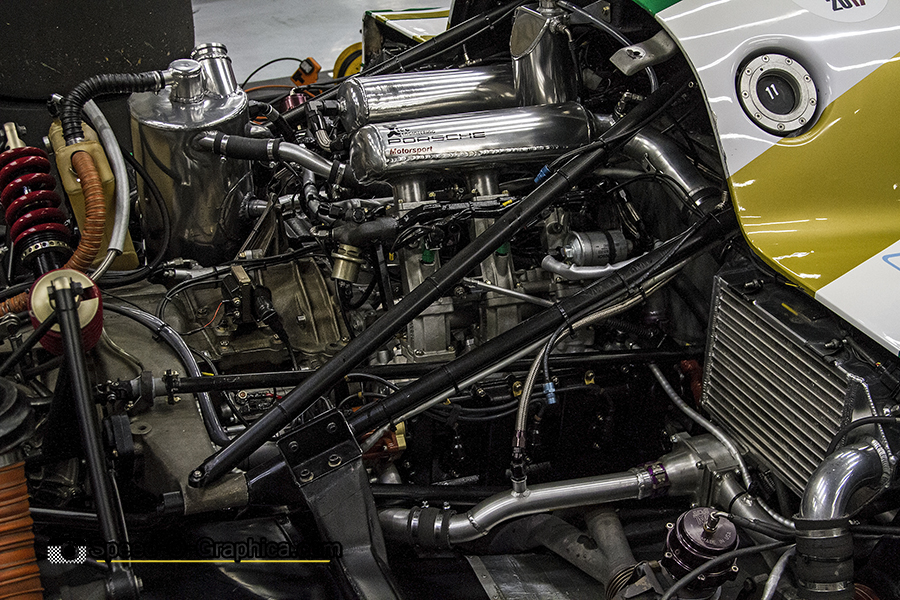Group C: The Rise and Fall of the Golden Age of Endurance Racing: Porsche 962 part 1

By Marcel Hundscheid / Speed-O-Graphica
In this episode of our Group C retrospective, we tackle the legacy of Porsche’s legendary 962 – one of the most successful sports racing cars in history.
The car was meant as a replacement for the earlier 956, which was raced extensively in Group C mainly in Europe and Japan. The United States had their own remarkable championship – IMSA – but, in contrast to Group C where consumption-limited engines were used, IMSA regulations had no restrictions. This in itself was comparable for the illustrious CanAm Championship from the late ’60s and early ’70s. This was further underlined when it turned out that FISA World Championship races were literally killed by fuel-saving regulations. Another difference was the absence of factory teams in the IMSA championship, while they had full grids.

Pictured on top of the page and above is chassis 962-116 seen in the pitlane at Spa-Francorchamps during the Peter Auto’s Spa Classic back in 2017.
With the intention to end the dominance of the Porsche 935 in 1982, IMSA introduced the GTP class. GTP was a modified Group C class, with slight aerodynamic changes and the same tire size on each axle. The 962’s predecessor, the Porsche 956 with the biturbo engine, was not homologated.
As the 956s were not allowed to drive in the IMSA they saw action in the Sports Car Club of America (SCCA). Strong performances there and victory of the 956 on American soil had also convinced team bosses. Joint efforts were made to change IMSA’s mind, but when it turned out that the feet of the driver in the Porsche 956 appeared to be in front of the front axle, the car was permanently banned.

Illustrated above is Porsche 962 (962-131) driven by Michel Lecourt captured at Peter Auto’s Le Mans Classic in 2016.
Nevertheless, the interest from customer teams in particular was so great that it was more than interesting for Porsche to build an IMSA version of the 956, known as the Porsche 962. This car was equipped with a steel cage instead of the aluminium used in the 956. Besides this, the driver’s feet were behind the front axle. For this purpose, the front wheels including the axle were placed forward, which resulted in a shorter front end. As a result the 962 12 cm longer in wheelbase than the 956.

Porsche 962C (962-154) of Pierre-Alain France raced in Japan for most of its life and appeared at the 1990 Le Mans 24 Hours. Seen here the car was captured at Peter Auto’s Spa Classic in 2016.
Powered by an air cooled single turbo 2.87 liter engine, 962-001 made its racing debut at the 24H of Daytona in early February 1984 with drivers Mario and Michael Andretti. And once again the Americans weren’t amused by the appearance of the 962. When the earlier 956 arrived on the scene they pushed as hard as they could to limit the performance of this car. After just four hours of racing Porsche withdrew the car due to engine cooling problems.

Seen here is the heart of chassis 962-141, the 780 hp 2.994 cc twin turbo water cooled engine based on the 935.
Before Al Holbert claimed his first victory with the 962 in June 1984 at Mid-Ohio, the 2.87 liter car was able to finish in second place in each of the next four IMSA races. At the next race Holbert replaced the 2.87 liter factory engine with an Andial-prepared 3.2 liter engine. Porsche understood that in the IMSA championship only this engine could compete with Chevrolet’s powerful V8 engines. Porsche optimized the Andial engine as a factory support.
In our next story about the Porsche 962, we’ll head to the arena in which it earned perhaps its greatest fame – the World Sportscar Championship.
